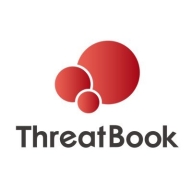

Recorded Future and ThreatBook are competitive threat intelligence platforms that deliver valuable cybersecurity insights. While ThreatBook offers superior features, Recorded Future performs slightly better in pricing and support.
Features: Recorded Future provides vast data collection, intuitive analytics, and effective threat identification. ThreatBook is known for comprehensive real-time threat intelligence, superior local insights, and deeper regional focus.
Ease of Deployment and Customer Service: Recorded Future offers streamlined deployment and extensive support for a smooth integration experience. ThreatBook's deployment process is straightforward but may require additional local configuration. Recorded Future holds a slight advantage in ongoing user support.
Pricing and ROI: Recorded Future has competitive pricing and strong ROI due to efficient threat management. ThreatBook's setup costs are higher, but its advanced features provide substantial long-term ROI.

Recorded Future is a powerful and effective cyber threat intelligence (CTI) platform that aims to empower administrators to protect their organizations from threats, both known and unknown. The machine learning engine that Recorded Future utilizes can process the same amount of data that 9,000 analysts working five days a week, eight hours a day for an entire year can process. It simplifies threat detection and remediation so that organizations can focus on other tasks.
Recorded Future Benefits
Some of the ways that organizations can benefit by choosing to deploy Recorded Future include:
Recorded Future Features
Some of the many features Recorded Future offers include:
Reviews from Real Users
Recorded future is a solution that stands out when compared to its top competitors. Two major advantages it offers are the threat research tools that it provides and the threat monitoring capabilities that it enables users to leverage.
A security operations lead at a comms service provider writes, “Recorded Future covers a lot of different use cases. For example, we are using it for threat intelligence research. We do use the tool to make active research on what is found around the threat. We look at patterns, for example, and see what can be elaborated on from that.”
They also write, “We can also use it for active monitoring in the customer interface. We can monitor the business side of a campaign. We can monitor for specific threats or market activity on the dashboard. We can develop queries to run in a continuous mode in order to get the best reviews.”
ThreatBook is a cybersecurity platform that provides advanced threat intelligence to protect networks from evolving threats, utilizing real-time data analytics and comprehensive reporting to bolster defenses.
Designed for enterprises, ThreatBook equips IT teams with insights into the latest threats, integrating seamlessly with existing security infrastructures. It focuses on proactive threat detection and incident response, offering a deep understanding of threat landscapes. The platform is appreciated for its ability to deliver actionable intelligence, enhancing overall network security posture.
What are the key features of ThreatBook?In finance, ThreatBook implementation helps safeguard sensitive financial data, while in healthcare it protects patient information by preventing data breaches. It also supports manufacturing businesses by securing intellectual property from cyber espionage. Each industry benefits from features tailored to its specific threat landscape and priorities.
We monitor all Threat Intelligence Platforms reviews to prevent fraudulent reviews and keep review quality high. We do not post reviews by company employees or direct competitors. We validate each review for authenticity via cross-reference with LinkedIn, and personal follow-up with the reviewer when necessary.